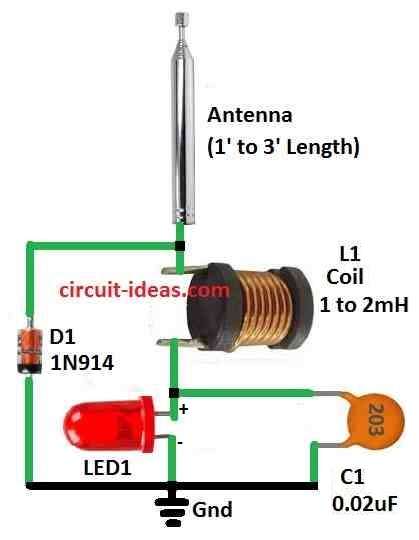This article for Simple RF Sensor without Battery Circuit show how to make small tester with no battery.
It help check if radio transmitter is working or not.
The tester get power from radio waves which is sent through transmitter.
If transmitter works LED light will blink to show it.
What is a RF Sensor without Battery:
RF sensor with no battery is wireless sensor which can find radio signals but not uses normal battery or other power.
But this sensor take small power from radio signals around it and this is called energy harvest.
This kind of sensor are good for many uses like Internet of Things, factory work and checking environment.
Circuit Working:

Parts List:
| Category | Description | Quantity |
|---|---|---|
| Capacitors | ||
| 0.02µF | 1 | |
| Semiconductors | ||
| Diode 1N914 | 1 | |
| Bright LED (any type) | 1 | |
| Antenna (as given in diagram) | 1 | |
| Coil (as given in diagram) | 1 |
This is how RF sensor circuit with no battery works:
The circuit uses antenna to catch RF signal and antenna can be simple wire or small stick antenna.
When RF transmitter is ON it sends out radio signals and the antenna catches these radio waves.
These radio waves make small voltage in the antenna wire.
One diode mostly germanium diode take this voltage and changes AC signal which is radio wave into DC signal of normal power.
This changing from AC to DC is called rectification which helps to make useful DC power from radio signal.
This power goes to capacitor and this capacitor is small part that keep power for short time.
The power in capacitor is used to turn ON LED light called LED1 in the circuit diagram.
When power in capacitor is enough to reach certain voltages then the LED1 light turn ON.
LED should be high brightness type because RF power is very small because the normal LED may not work good.
To test if RF transmitter is working we bring sensor antenna close to transmitter antenna.
This gives strong signal to sensor.
If RF signal is coming then sensor makes enough voltage to charge capacitor and light the LED1.
When LED1 turns ON it means RF signal is found and working.
Formula:
Formulas for Simple RF Sensor without Battery:
Main Idea: Diode Rectification:
This circuit work like simple rectifier using diode.
Diode let current goes in one way but stop it going back other way.
We can understand diode working with this formula:
Id = Is × (exp(Vd / (n × kB × T)) – 1)
where:
- Id is current going through diode
- Is is small leakage current called saturation current
- Vd is voltage across diode
- n is ideality factor of diode value between 1 and 2
- kB is Boltzmann constant
- T is temperature in Kelvin
How circuit work:
Diode D1 take weak AC voltage from antenna and turn into DC.
When AC signal goes positive then diode lets current pass and capacitor C1 get charged.
When AC connects negative, then diode stop current with no flow.
Capacitor C1 keep this charge and help make DC more stable with less ripple for using in next parts of the circuit.
Note:
This formula show how voltage and current behave in diode.
We do not use it directly for this simple circuit but it help to understand how diode work.
How to Build:
To build a Simple RF Sensor without Battery Circuit follow the below mentioned connection steps:
Choosing LED:
- Use high brightness LED so it can light up well using small power from RF signal.
Tuning the Antenna:
- We can use old pull up antenna from TV or CB radio or just use simple wire.
- This wire will work as antenna for the circuit.
Housing for Circuit:
Connecting the Circuit:
- Connect LED1 to the circuit.
- LED1 will turn ON when RF signal is found.
- This circuit is special because it needs no battery or outside power.
How to Test:
- Turn ON CB radio or ham radio which we want to test.
- Put the circuits antenna close or touching the transmitter antenna.
- Watch LED1 if LED1 turns ON it means RF signal is coming and circuit is working.
Conclusion:
This small and Simple RF Sensor circuit can test RF transmitters with no battery.
It uses RF signal energy to light the LED.
It is very good idea for hobby people or beginners who want easy RF project.
Leave a Reply